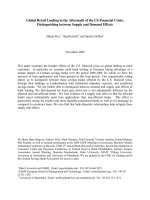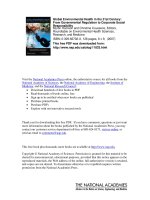Global brand communities
Bạn đang xem bản rút gọn của tài liệu. Xem và tải ngay bản đầy đủ của tài liệu tại đây (539.34 KB, 20 trang )
Global brand communities across borders: the
Warhammer case
The Authors
Bernard Cova, Euromed, Marseilles, France
Stefano Pace, Bocconi University, Milan, Italy
David J. Park, Xavier University, New Orleans, Louisiana, USA
Acknowledgements
The authors would like to thank Sameer Deshpande at the University of Lethbridge, Canada for his
much valued assistance in this paper. His keen intellect, insight and rigorous scholarly dedication
greatly enhanced the overall presentation and argument in this paper.
Abstract
Purpose – The “brand community” concept believes that the meaning of the brand transcends
national boundaries. However, such an assumption presents challenges arising out of several
reasons including co-existence of sub-tribes within a given brand community that allocate different
meanings to a particular brand. This plurality of meanings seems exacerbated for global brands
where meanings are shaped by tremendously varying cultures. Aims to address the issues.
Design/methodology/approach – This text relies on a comparative study of the meanings
attributed to one particular global brand, Warhammer, by the members of its brand community in
France and the USA.
Findings – Findings highlight the elements of homogeneity and heterogeneity that reside in the
cross-border meanings of the brand. The authors also discuss the marketplace relevance arising out
of this plurality that should be taken into account by global marketers.
Originality/value – The present text argues that community attached to a global brand constitutes
a complex phenomenon, one that both integrates and ignores geographical considerations.
Article Type:
Research paper
Keyword(s):
Culture; Brands; Communities.
Journal:
International Marketing Review
Volume:
24
Number:
3
Year:
2007
pp:
313-329
Copyright ©
Emerald Group Publishing Limited
ISSN:
0265-1335
Introduction
Over the past decade, a postmodern outlook paved the way for so-called communal approaches to
consumption (Cova, 1997). Two pioneering examples were the group of river rafters which was
depicted in Arnould and Price's (1993) ethnographic journey as a “communita” and the subculture
of bikers which was detailed in Schouten and McAlexander's (1995) article. The behaviour of
consumers driven by a similar passion or ethos to assemble into a group, thereby becoming a
subculture or tribe as coined by Maffesoli (1996), came to be seen as an object of study with
relevance to the field of marketing (Kozinets, 2001, 2002; Thompson and Troester, 2002).
Reincorporating recent studies on the complex relationship between brands and consumers
(Fournier, 1998; Holt, 2004) into this communal approach, a “brand community” concept
(Algesheimer et al. , 2005 ; McAlexander et al. , 2002 ; Muniz and O'Guinn, 2001) then came to the
forefront of the marketing scene. Although some studies (Muniz and O'Guinn, 2001) have been
attempting to clarify the object of study by differentiating between the three neighbouring concepts
of “brand community,” “sub-cultures of consumption” and “consumer tribes” (or even “brand
tribes”), it should also be noted that many authors seem not to be troubled by a lack of
differentiation, moving seamlessly within one and the same text from the concept of community to
tribe (Solomon, 2003), or from tribe to sub-culture and even micro-culture (Thompson and
Troester, 2002). It remains that the brand community concept (Muniz and O'Guinn, 2001;
Wipperfürth, 2005) refers more to a group of people who share their interest in a specific brand
and create a parallel social universe ripe with its own values, rituals, vocabulary and hierarchy.
From an international branding point of view, the brand community concept introduced the
exciting possibility of managing these brand communities at a global level regardless of geography
(Deeter-Schmelz and Sojka, 2004): the meaning of the brand is supposed to be able to transcend
national boundaries. However, some problems are faced when trying to manage these brand
communities (O'Guinn and Muniz, 2005). One key element in communal consumption (Kozinets,
2001) is the co-existence within a given brand community of a variety of sub-tribes allocating
different meanings to a particular brand, and sometimes going as far as to do battle with another.
This plurality of meanings and proliferation of latent conflicts seems exacerbated by the existence
of global brands that, under the aegis of a brand community, mobilise various groups with deep
roots at a regional level. Based on their domestic US study Muniz and O'Guinn (2001, p. 413)
affirm that brand communities are “liberated from geography.” On the other hand, the present text
argues that community attached to a global brand constitutes a complex phenomenon, one that
both integrates and ignores geographical considerations.
Towards this end, this text relies on a comparative study of the meanings attributed to one
particular global brand, Warhammer, by the members of its brand community in France and the
USA. The study followed the same protocol in both countries. Findings highlight the elements of
homogeneity and heterogeneity that reside in the cross-border meanings of the brand.
Global brand communities
Muniz and O'Guinn (2001) identified the distinguishing features of brand communities, using three
constructs:
1. consciousness of a kind, i.e. a sense of belonging to an in-group, thanks to a brand that is
patronized by all of the group members;
2. evidence of rituals and traditions that surround the brand; and
3. a sense of obligation to the community and its members which is often, but not always,
shared by members of the group (e.g. in regard to product repairs or more personal
services).
However, above and beyond recognizing the diversity in characteristics of sub-tribes, it is also
crucial for marketers to note the problems they can cause (O'Guinn and Muniz, 2005). These
include:
• Oppositional brand loyalty (the very defining nature of the brand community is its
opposition to another brand and its tribe).
• Marketplace legitimacy (there is a debate around who is a legitimate purchaser of the
brand?, i.e. who is a true believer and brand community member?).
• Desired marginality (brand community members actively try to keep the community small
and marginal).
• The polit-brand (a brand community that has at its centre the particularly politicised brand).
• The abandoned tribe (a brand community in which the marketer has abandoned the brand,
but the community still thrives as with Apple's Newton; Muniz and Schau, 2005).
• Who owns the brand?
• This is an obvious question … Brand communities assert considerable claims on ownership
… These impassioned and empowered consumer collectives assert more channel power
and make claims on core competencies formerly reserved for the marketer (O'Guinn and
Muniz, 2005, p. 268).
However, O'Guinn and Muniz (2005) seem to exclude from the above list of problems anything
that might relate to geography, since they believe that brand communities “may transcend
geography” (Muniz and O'Guinn, 2001, p. 415). Furthermore, by emphasizing members' level of
legitimacy, the authors analyse potential oppositions or conflicts between members or sub-tribes in
a religious light (Muniz and Schau, 2005) as opposed to a geographical one. This is relatively
congruent with the findings of the few studies that currently exist on the creation of meaning
within a brand community (Arnould and Thompson, 2005). Few brand community studies have
addressed how different groups of consumers co-create meanings regarding the same brand
(Broderick et al. , 2003 ; Schouten and McAlexander, 1995; Wipperfürth, 2005). However, these
studies tend to emphasize homogeneity of brand meaning within a particular subculture or subset
of consumers.
On the contrary, few works emphasize the co-existence of multiple interpretive sub-tribes within a
same brand community (Kozinets, 2001); a co-existence which can sometimes lead to conflict. For
example, in the world of Star Trek, one has to distinguish between “trekkers” and “trekkies.”
Again, Kozinets (2001, 2002), Muniz and O'Guinn (2001) or O'Guinn and Muniz (2005) studies
are essentially built on homogeneous foundations whose nature is either exclusively North
American (off-line) or on-line and net-based (a solution that de-territorialises exchanges). No
consideration has been given to the possibility of geographic diversity inside a brand community.
Kates and Goh (2003) introduce the expression “morphing” when referring to brands in order to
describe the phenomenon of meaning alteration that naturally occurs within communities. The
meaning attached to a given brand is considered local and is anchored to the specific community
where that brand is experienced. The authors refer to this phenomenon within the international
context of advertising. An advertiser can adapt its communication strategy according to the
strength of the morphing to which its brand is submitted. The marketer can also foster this
morphing. The authors acknowledge that “the brand communities studied by Muniz and O'Guinn
(2001) are excellent examples of brands acting as quintessentially morphed and relevant symbolic
figures in consumers' lives” (Kates and Goh, 2003, p. 65). Although they recognize the relevance
of the difference of national cultures, the two authors assume a managerial perspective dealing
with segmentation and positioning that might be not applicable. In fact, the company may face not
a traditional market, but a bundle of very small communities whose activity may be totally
unknown to the company. For example, in Deeter-Schmelz and Sojka's (2004) study of World
Wrestling Entertainment (WWE) subculture, several shared values are identified for US fans.
However, the authors still wonder if the meaning of this event, which is broadcast in 162 countries
and translated into 11 different languages, transcends national boundaries:
… is it possible for a subculture to retain cohesive values within the context of radically different
core cultures? Would the values motivating WWE fans in Indonesia, India, Australia and the
Dominican Republic, for example, be similar in spite of the diverse core culture? (Deeter-Schmelz
and Sojka, 2004, p. 141).
Indeed, a global brand constitutes different local sub-tribes spread across the world – justifying the
hypothesis that they attribute varying meanings to it. A major reason for this belief is inherent to
the recreation of brand meaning, which is central to postmodern consumption. As Arnould and
Thompson (2005) would posit, the consumer reworks and transforms any meaning that the market
presents to him/her. Consumers are “unruly bricoleurs”: bricoleurs, since they take diversified
meanings encoded in different market sources, such as advertisements and brands; unruly, since
they do not respect any rule with the exception of one's own identity. This phenomenon becomes
particularly relevant when specific meanings are not lived by insulated individuals, but ingrained
in a community (Thompson, 2004).
This study hopes to show that for a global brand:
• there are different sub-tribes living in different territories;
• these sub-tribes share some common meanings ascribed to the global brand;
• they also develop their own meanings of the global brand and consequently, a specific local
subculture; and
• this plurality of meanings across territories has marketplace relevance that should be taken
into account by global marketers.
Methodology
Warhammer is a strategic battle game played with various miniatures on a “battlefield.”
Warhammer belongs to Games Workshop, UK (Nottingham), the largest and the most successful
tabletop wargames company in the world. Its two major brands are Warhammer, and Warhammer
40,000. It also holds a global license for a tabletop battle-game based on the film trilogy The Lord
of the Rings. It has direct sales operations in the UK, the USA, Northern Europe, Canada, France,
Germany, Spain, Australia, Italy and Japan. With around 70 percent of sales coming from outside
of the UK, the Group and its leading brand Warhammer are truly global. It is a social and convivial
activity loved by millions of gamers, who spend many of their waking hours collecting, creating,
painting, and building up the metal or plastic miniature armies that they will go on to command on
a carefully prepared tabletop battlefield (Figure 1).
Multiple methodologies were used to study the two different Warhammer sub-tribes, one in France
and the other in the USA. Data about the tribe was primarily gathered using naturalistic inquiry
and in-depth unstructured interviews. Data was also collected using non-participatory observation,
photography and audio recording. All the interviews were conducted in or around the Warhammer
game room. In the USA, the game room (C&C games shop) was independent from the Games
Workshop company, while in France the game room (Games Workshop shop) was not.
The interviews took place on Wednesday evenings or Saturday afternoons. Individual respondents
discussed Warhammer at a separate table in the same game room or shop while other enthusiasts
played or painted figurines roughly ten meters away. Rather than conducting numerous interviews
with the same participants, we chose to interview a variety of gamers to acquire as much breadth as
possible given the limited experience some informants had with the game. Our interviews turned
out to be more like conversations, where the questions bounced off the answers. Every interview
was recorded following the written consent of each participant.
We chose not to separate the tribe from its own environment, as we believe the interaction of all
environmental factors surrounding the respondents was needed to make a thick characterization of
the tribe. Furthermore, we felt the respondents were more relaxed and accommodating when they
were interviewed in their own environments. They were painting, playing and interacting with
each other in the game room.
In each of the two selected cities (Marseilles in France and Madison, Wisconsin in the USA), we
conducted 11 in-depth interviews to acquire information on how participants consume and ascribe
meaning to Warhammer. All respondents were males of varying ages and experience levels
although most respondents were between the ages of 16 and 24. Given that male teenagers may
have difficulty expressing feelings, we sometimes employed a projective approach for acquiring
descriptions. We asked respondents what they thought about how other people perceived the issue
in question.
Later, we categorized our data through classifying and labelling processes suggested by
McCracken (1988). The categorization processes helped develop the themes (Spiggle, 1994). In
addition to categorization, we incorporated triangulation in all stages of our research. Then, we
employed member checks to test some of the analyses with the study's participants (Lindlof, 1995).
In our case, member checks involved showing some portions of our report to the project
informants. Their commentaries on the interpretations in the report were sought as a check on the
viability of the interpretations (Belk et al. , 1989 ). In order to assess the credibility of our
interpretations we went back to the game room and showed our findings on three of the themes to
our informants. “Socialization” and “attraction to imaginary violence” themes were omitted
because of potential to interfere with the subjects personal relationships. The member checks
resulted in no significant changes being made in our interpretations. In sum, member checks, data
triangulation and additional reviewers were used in our data interpretation.
Results
Warhammer consumers clearly ascribed communal attributes to their groupings as they have been
highlighted in recent studies (Muniz and O'Guinn, 2001). First, unlike other games, the
Warhammer members share the sense of forming a specific group even if it's not a close one:
Confrontation, there isn't the same community feeling as we have with Warhammer. There's a lot
of us doing Warhammer, and we're all connected by the White Dwarf (William).
A group, oh yes! But not a separate one, since we're open to everyone, we don't believe in
segregation. Someone who shows up, even if he or she isn't playing, we get them involved
specifically so they'll be interested in painting or playing (Georges).
Second, Warhammer members stipulate the existence of rituals and traditions:
There is a community of equals but with a hierarchy. You start out with the older players, who
have been doing tournaments for at least 3 years. Locally we all know each other, we're all friends.
And there is a hierarchy with the younger players who are just beginning to show up and dream
about capturing the scalp of one of the older ones (Reynald).
He's had the empire rule book for a while, because he's developing what we should have in our
army because there's very strict rules on building armies and he has to adhere to those rules to
make the army (Dave).
Third, they put emphasis on the moral obligation to help one another:
There's a lot of mutual support since no one is familiar with the entire rulebook – we each know
just a small portion of it (Christophe).
At the beginning we helped each other a lot, but now we're getting a little more competitive
(Michael).
The first theme that surfaced from the US interviews was “socialization.” It connotes how the tribe
of Warhammer enthusiasts socializes inside and outside of the “C&C Game Room” that serves
them as a community. The notion of friendship was mentioned several times as a main reason why
the enthusiasts hang out together. One of the respondents said:
This game led to a lot of friendships for me and that's one reason why I play it. I like the game
obviously that's another reason (Jim).
However, we discovered that this can be a superficial and fragile friendship based solely on the
game and the game room. The game room is the only thing that connects the enthusiasts. Here,
friendship can be seen as a function of the game and the room. In some of the interviews the
respondent made that pretty clear to us. One respondent noted:
If I didn't work here tomorrow and I didn't go with them we would probably not talk (Jack).
Consequently, this tribe appears as if it may not have much of a social life outside the game room,
but it does socialize a lot within its walls. Nonetheless, the depth of the relationship can also be
questioned. Few of the respondents socialized with each other away from the gaming centre. Thus,
even though they believed the people at the gaming center were their good friends, they rarely
spent time with one another. As a result, the socialization theme can be seen as simultaneously
entailing two opposing elements.
The French findings concur with the US results that feature varying degrees of socialisation. Some
people enter the Warhammer universe via friends who introduce them, whilst others make new
friends (albeit not with everyone) thanks to the Warhammer universe. Several participants mention
the existence of two totally distinct social groups:
70 percent of my group of friends are from there (Reynald).
Players don't see each other except at the shop. There is some feeling of friendship, but I do have
other friends. These are two totally separate social groups (Yann).
The second theme that emerged was “Attraction to imaginary violence.” Almost all of the US
respondents held an attraction to violent imagery. In fact, there seemed to be two main themes with
violence that surfaced within our interviews. First, most of the informants used violent imagery in
their descriptions of the game. We simply refer to this component as “violent discourse.” The
second theme that surfaced in the interviews is referred to as “violent influences.” Media may have
influenced the respondents' attraction to imaginary violence. Here are a few examples of
respondents' descriptions of why they are attracted to Warhammer:
When I get here it is just fun and kill, kill, kill. Also like in classes, if you mess up it is bad, like
here if you mess up, so what you live and learn I mean you'll do better next time (Roger).
When I play? Anxious, I want to get in there and kill stuff! (Tex).
I guess it is general nature for humans to be better than everyone else. Like my army is better than
yours. Bragging rights. But I don't think there's nothing better than sinking an axe in someone's
head (Tex).
In addition, some of the US males described in detail how they enjoyed imagining some of the
“smells and tastes” of battle. One could also observe the US respondents play “Streetfighter” in
between Warhammer matches. Streetfighter is another violent video game where players can
manipulate various fight scenes in urban areas. Surprisingly, this theme was never spontaneously
evoked in the French interviews and when it was mentioned, it was rejected as something
irrelevant. What attracts the French male is an imaginary world that is historical, medieval,
backwards-looking and full of heroic fantasy – not the violence itself (Figure 2). In fact, no one
even mentioned this factor, not even the players' parents:
What I like is the story line, as well as the strategic side of things (Cyril).
No one ever talks to me about a universe of violence. They focus on the aesthetic aspects
(Georges).
You don't see it … All you get is a really friendly ogre with 3 attacks and 3 life points (Ouard).
It is also interesting to note that the French players we interviewed expressed a general dislike for
on-line sites or forums dedicated to Warhammer. They do not feel at home in these kinds of “crazy
environments” where an imaginary violence often runs rampant.
The third theme in the US interviews was “Accomplishment.” As the informants began to
elaborate on the miniatures they revealed a focus on the actual interactions with physical figurines.
They were drawn by the visual appeal of figures and often invested a lot of time and effort in
painting and assembling these warrior replicas. When some of the informants lost a “battle” or









